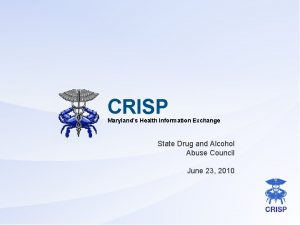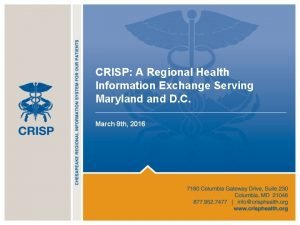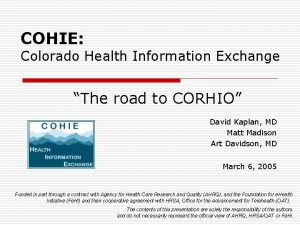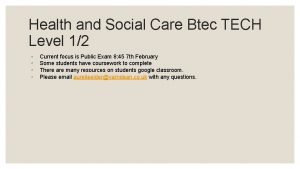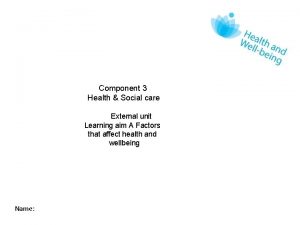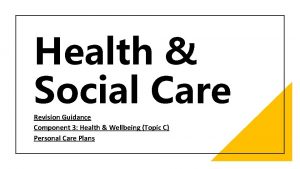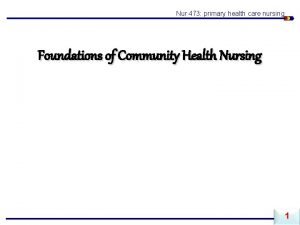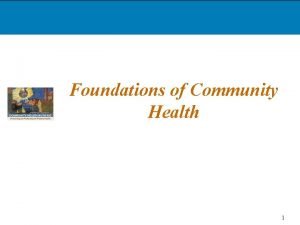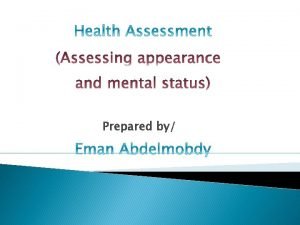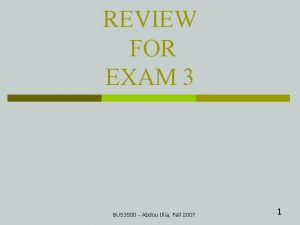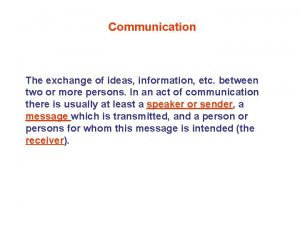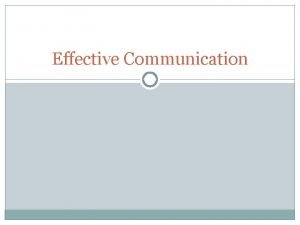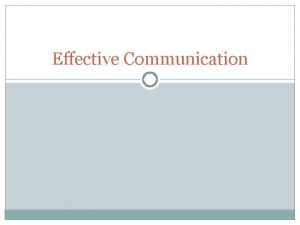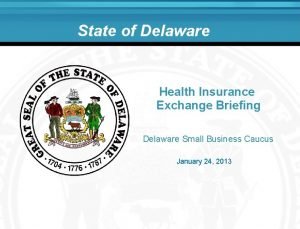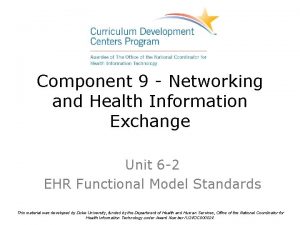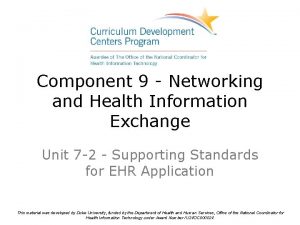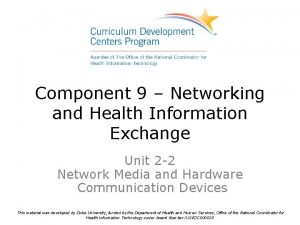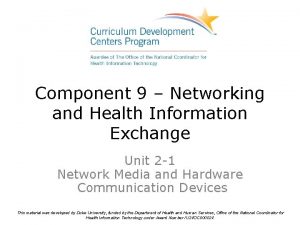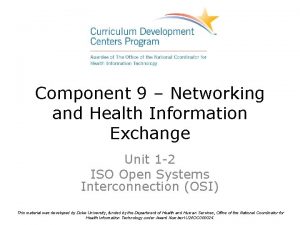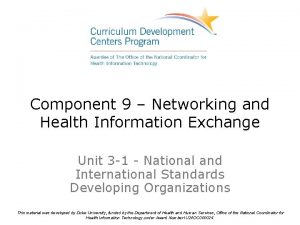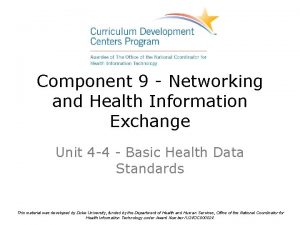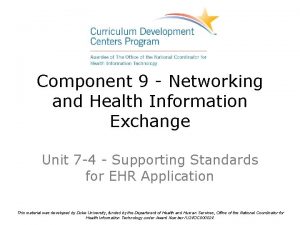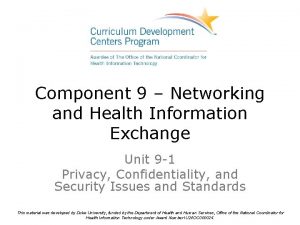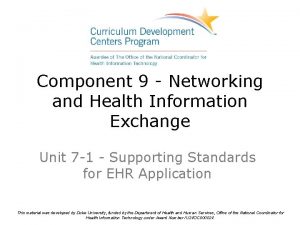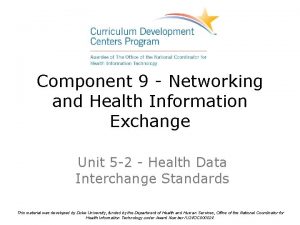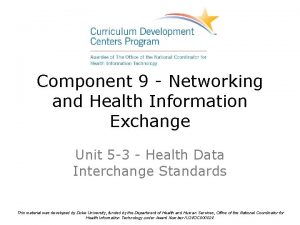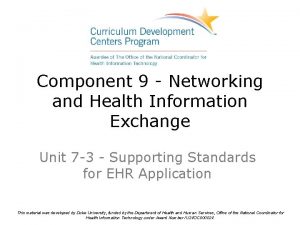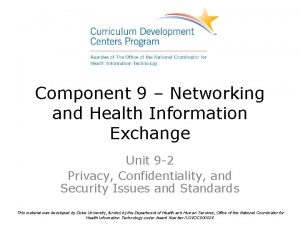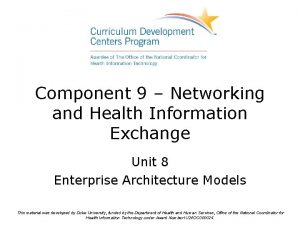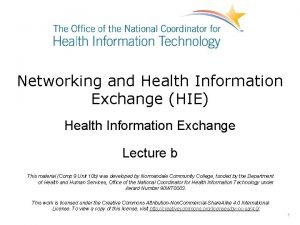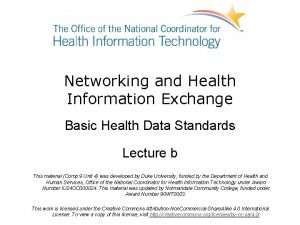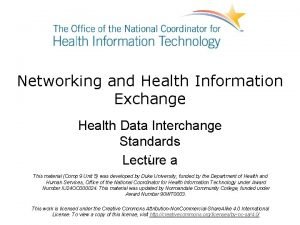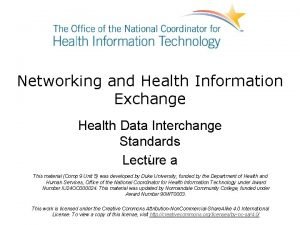Component 9 Networking and Health Information Exchange Unit







![SNOMED Axes • • • Findings [F] Procedures [P] Body structures (anatomy) [T] Morphology SNOMED Axes • • • Findings [F] Procedures [P] Body structures (anatomy) [T] Morphology](https://slidetodoc.com/presentation_image/215668a70fc5e7518ed9aa377912ee4f/image-8.jpg)










![Unified Medical Language System "The purpose of the [Unified Medical Language System] is to Unified Medical Language System "The purpose of the [Unified Medical Language System] is to](https://slidetodoc.com/presentation_image/215668a70fc5e7518ed9aa377912ee4f/image-19.jpg)




- Slides: 23

Component 9 - Networking and Health Information Exchange Unit 4 -3 Basic Health Data Standards This material was developed by Duke University, funded by the Department of Health and Human Services, Office of the National Coordinator for Health Information Technology under Award Number IU 24 OC 000024.

Unit 4 -3 Objectives • Understand the use, purpose and interrelation among sets of controlled vocabularies in use today • Identify the more common controlled vocabularies in use today: SNOMED, MEDCIN, Med. DRA, Nursing terminologies, Me. SH and UMLS Component 9/Unit 4 -3 Health IT Workforce Curriculum Version 2. 0/Spring 2011 2

Evolution of SNOMED • Systematized Nomenclature of Diseases and Organisms (SNDO) - 1928 - NY Academy of Medicine • Systematized Nomenclature of Pathology (SNOP) - 1965 • Systematized Nomenclature of Medicine (SNOMED) - 1979 • SNOMED-RT (Reference Terminology)(1999) • SNOMED-CT (Merger with Read)(2002) • International Healthcare Terminology SDO (2007) Component 9/Unit 4 -3 Health IT Workforce Curriculum Version 2. 0/Spring 2011 3

SNOMED-CT • Created by the merger, expansion and restructuring of SNOMED-RT and Read Codes • 344, 000 concepts, 450, 000 medical descriptions, 700, 000 concept interrelations • Cross maps to ICD 9 -CM, ICD-10, LOINC Component 9/Unit 4 -3 Health IT Workforce Curriculum Version 2. 0/Spring 2011 4

SNOMED-CT Components • • Concepts Descriptions Hierarchies Relationships Component 9/Unit 4 -3 Health IT Workforce Curriculum Version 2. 0/Spring 2011 5

Example 284196006|Burn of skin|: 246112005|Severity|=24484000|severe 363698007|Finding Site|= (113185004|Structure of skin between fourth and fifth toes|: 272741003|Laterality|=7771000|left) Such expressions are said to be post-coordinated as contrasted to pre-coordinated terms. Component 9/Unit 4 -3 Health IT Workforce Curriculum Version 2. 0/Spring 2011 6

Semantic Representation in SNOMED-CT Bacterial Pneumonia Tularemia is-a s-f ha Lung Structure Component 9/Unit 4 -3 ing ind e t -si Pulmonary h as -c Tularemia au sa associatedmorphology Inflammation Health IT Workforce Curriculum Version 2. 0/Spring 2011 tiv ea ge nt Francisella tularensis 7
![SNOMED Axes Findings F Procedures P Body structures anatomy T Morphology SNOMED Axes • • • Findings [F] Procedures [P] Body structures (anatomy) [T] Morphology](https://slidetodoc.com/presentation_image/215668a70fc5e7518ed9aa377912ee4f/image-8.jpg)
SNOMED Axes • • • Findings [F] Procedures [P] Body structures (anatomy) [T] Morphology [M] Organisms [L] Substances [C] Physical agents [A] Occupations Social context General Other Component 9/Unit 4 -3 Health IT Workforce Curriculum Version 2. 0/Spring 2011 8

Terminology Model • Ruptured ovarian cyst (D 7 -75111) – Is a disease (D 7 -00000) – Has morphology rupture (M-14400) – Has morphology cyst (M-33400) – Has topography ovary (T-87000) Example is SNOMED – RT. Component 9/Unit 4 -3 Health IT Workforce Curriculum Version 2. 0/Spring 2011 9

MEDCIN • System of standardized medical terminology developed by Medicomp Systems • Includes over 250, 000 clinical data elements encompassing symptoms, history, physical exam, tests, diagnoses and therapy Component 9/Unit 4 -3 Health IT Workforce Curriculum Version 2. 0/Spring 2011 10

International Classification for Primary Care (ICPC) • Used by individual family practices and group practices • Use is to record primary care patient encounter – Includes reason for encounter (chief complaint) – Focuses on patient perspective • Includes fear of disease • Request for preventive services • Request for treatment Component 9/Unit 4 -3 Health IT Workforce Curriculum Version 2. 0/Spring 2011 11

Medical Dictionary for Regulatory Activities (Med. DRA) • International medical terminology used by regulatory authorities and regulated biopharmaceutical industry • Terminology for coding all medical data obtained during all phrases of development and marketing: – – – – Symptoms Signs Disease Diagnoses Indications Investigations/Procedures Medical/Social History Component 9/Unit 4 -3 Health IT Workforce Curriculum Version 2. 0/Spring 2011 12

Med. DRA codes • Unique 8 digit number, starting with 10000001 • As terms added, codes assigned sequentially • Example – Gastric hemorrhage (LLT) = 10017789 – Gastric haemorrhage (LLT) = 100177188 – Gastrointestinal disorders (SOC) = 10017947 Component 9/Unit 4 -3 Health IT Workforce Curriculum Version 2. 0/Spring 2011 13

Nursing Terminologies • • NANDA Taxonomy Clinical Care Classification Patient Care Data Set Omaha System AORN Perioperative Data Set International Classification of Nursing Practice Nursing Interventions Classification Nursing Outcomes Classification Component 9/Unit 4 -3 Health IT Workforce Curriculum Version 2. 0/Spring 2011 14

Coding Nursing Concepts • • Diagnoses/Judgements Interventions Outcomes Goals Component 9/Unit 4 -3 Health IT Workforce Curriculum Version 2. 0/Spring 2011 15

Nursing Terminologies Diagnoses Interventions Outcomes NANDA X NIC X NOC X CCC X X PCDS X X Omaha X X X AORN X X X ICNP X X X Component 9/Unit 4 -3 Goals Health IT Workforce Curriculum Version 2. 0/Spring 2011 X X X 16

Medical Subject Headings (Me. SH) • Used to tag medical abstracts with concept -based information • Created to improve information retrieval • Introduces the notion of “context” for the same concept • Free for use in the US and in most countries Component 9/Unit 4 -3 Health IT Workforce Curriculum Version 2. 0/Spring 2011 17

Me. SH Example D 011014: Pneumonia D 018410: Pneumonia, Bacterial D 007877: Legionnaires' Disease D 011018: Pneumonia, Pneumococcal D 011019: Pneumonia, Mycoplasma D 009175: Mycoplasma Infections D 011002: Pleuropneumonia, Contagious D 011022: Pneumonia, Rickettsial D 011023: Pneumonia, Staphylococcal D 001996: Bronchopneumonia D 009956: Ornithosis D 011001: Pleuropneumonia D 011015: Pneumonia, Aspiration D 011017: Pneumonia, Lipid D 011020: Pneumonia, Pneumocystis carinii D 011024: Pneumonia, Viral Component 9/Unit 4 -3 Health IT Workforce Curriculum Version 2. 0/Spring 2011 18
![Unified Medical Language System The purpose of the Unified Medical Language System is to Unified Medical Language System "The purpose of the [Unified Medical Language System] is to](https://slidetodoc.com/presentation_image/215668a70fc5e7518ed9aa377912ee4f/image-19.jpg)
Unified Medical Language System "The purpose of the [Unified Medical Language System] is to improve the ability of computer programs to 'understand' the biomedical meaning in user inquiries and to use this understanding to retrieve and integrate relevant machine-readable information for users. " - Donald A. B. Lindberg, 1993 Component 9/Unit 4 -3 Health IT Workforce Curriculum Version 2. 0/Spring 2011 19

UMLS Structure • Three main components: – Metathesaurus – Semantic Network – Specialist Lexicon and tools Component 9/Unit 4 -3 Health IT Workforce Curriculum Version 2. 0/Spring 2011 20

Coverage: + minimal, ++ partial, +++ extensive Choice of terminologies HPI PMH Exam Labs ICD$ CPT$ + Diag Dx + ++ Rx ++ + DRG + + NDC +++ Rx. Norm +++ LOINC +++ + Nursing SNOMED Tx ++ +++ ++ Me. SH + + ++ ++ UMLS ++ ++ HPI: History of present illness PMH: Past medical history Exam-Physical exam Labs-Clinical lab Diag: Other tests Dx: Diagnoses Rx: Medications Tx: Otherapy Component 9/Unit 4 -3 Health IT Workforce Curriculum Version 2. 0/Spring 2011 21

Current Situation • SNOMED-CT is gaining momentum as the terminology of choice • LOINC is used in the US for laboratory test names • Rx. Norm is likely to be drug code of choice in US • ICD x is required for reimbursement • Adverse events – maybe Med. DRA Component 9/Unit 4 -3 Health IT Workforce Curriculum Version 2. 0/Spring 2011 22

Summary The complex problems caused by use of local terminologies and too many controlled terminologies continues to be an obstacle to interoperability. Until this problem is solved, the sharing and aggregation of data among disparate sites will result in a loss of information and prone to error. Component 9/Unit 4 -3 Health IT Workforce Curriculum Version 2. 0/Spring 2011 23
 Health and social care component 3
Health and social care component 3 Sdn vs traditional network
Sdn vs traditional network Crisp health information exchange
Crisp health information exchange Maryland health information exchange
Maryland health information exchange Cohie
Cohie Difference between health promotion and health education
Difference between health promotion and health education Information centric networking
Information centric networking Btec
Btec Health and social care component 2 learning aim b example
Health and social care component 2 learning aim b example Component 3 health and wellbeing
Component 3 health and wellbeing Addison currency exchange
Addison currency exchange Voluntary exchange activity the pearl exchange
Voluntary exchange activity the pearl exchange Gas exchange key events in gas exchange
Gas exchange key events in gas exchange Primary health care principles
Primary health care principles Eight characteristics of community health nursing
Eight characteristics of community health nursing Component of health assessment
Component of health assessment Lincoln pizza ordering system dfd
Lincoln pizza ordering system dfd Information thoughts
Information thoughts What are the factors of communication
What are the factors of communication Information thoughts
Information thoughts Information thoughts
Information thoughts The exchange of information thoughts ideas and feelings is
The exchange of information thoughts ideas and feelings is Unit 6 review questions
Unit 6 review questions Delaware health insurance exchange
Delaware health insurance exchange


